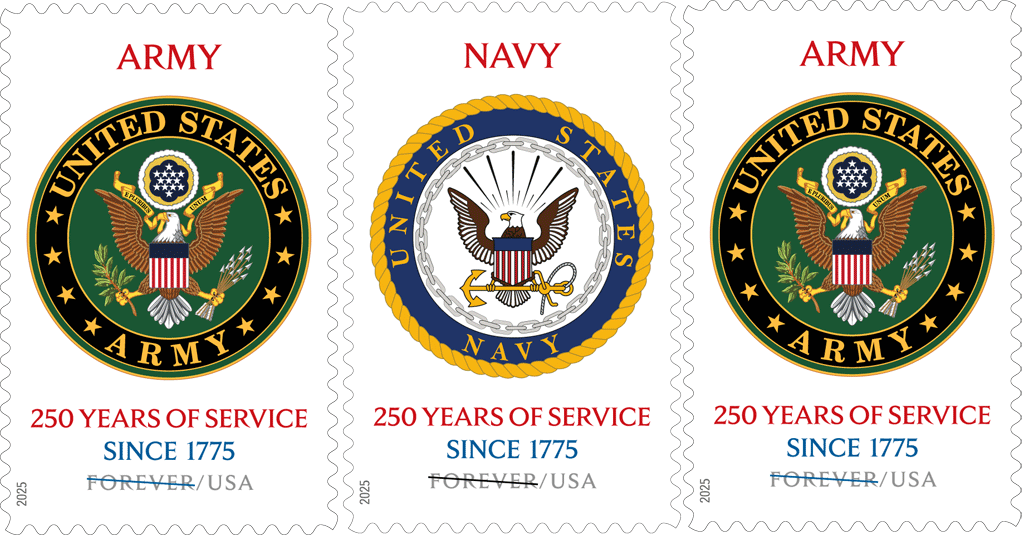 The US Postal Service will issue all three stamps on the same day in Washington, rather than in three separate ceremonies, as expected. How do you feel about that?
The US Postal Service will issue all three stamps on the same day in Washington, rather than in three separate ceremonies, as expected. How do you feel about that?
Author Archives: VSC
Behind the Betty White/Arthur Duncan Dragon Card
Now available:

Dgn 854 $4.00
You can see this and more on the Dragon Cards Web site.
The last line in the Dragon Card text is “Her show was canceled later that year.” The Duncan incident was never cited as the reason that the show was dropped; just declining ratings.
This was a common technique for the networks: They would move a show they wanted to dump around the schedule, often to unpopular time slots. Fans had trouble finding and watching these shows, so of course their ratings dropped.
Another reason for declining ratings for a show such as White was if the Southern affiliates didn’t carry the show, fewer people watched it and of course (again) the ratings dropped.
Stations do not have to carry a network’s shows. Often, if a show is doing poorly in the ratings, they will opt for something with a guaranteed income that they don’t have to share with the network. Even the network-owned stations, such as WCBS or KNBC, are free to drop the network shows for, say, “The Billy Graham Hour.”
USPS Seeks Rate Hike in July 2025

 “Put another nickel in…. ”
“Put another nickel in…. ” 
[press release] [click on any of the pictures for larger versions]
U.S. Postal Service Recommends New Prices for July
WASHINGTON, DC — The U.S. Postal Service today filed notice with the Postal Regulatory Commission (PRC) of mailing services price changes to take effect July 13. The new rates include a 5-cent increase in the price of a First-Class Mail Forever stamp from 73 cents to 78 cents.
The proposed adjustments, approved by the governors of the Postal Service, would raise mailing services product prices approximately 7.4 percent. If favorably reviewed by the commission, the price changes would include:
| Product Letters (1 oz.) Letters (metered 1 oz.) Additional Ounces Domestic Postcards International Postcards International Letter (1 oz.) |
Current Prices 73¢ 69¢ 28¢ 56¢ $1.65 $1.65 |
Proposed Prices 78¢ 74¢ 29¢ 62¢ $1.70 $1.70 |
The Postal Service is also seeking price adjustments for the Special Services products. Notably, the Postal Service will apply a price reduction of 12 percent for postal insurance when mailing an item.
As changes in the mailing and shipping marketplace continue, these price adjustments are needed to achieve the financial stability sought by the organization’s Delivering for America 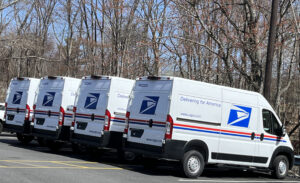 10-year plan. USPS prices remain among the most affordable in the world.
10-year plan. USPS prices remain among the most affordable in the world.
Following a directive from the PRC, the Postal Service is filing two sets of prices for Marketing Mail and Package Services products. While only one set of rates will go into effect on July 13, these prices address the pending proposal to eliminate Bound Printed Matter and expand Marketing Mail, pending the commission’s approval. USPS will release additional communications to address price changes in these categories.
The PRC will review the changes before they are scheduled to take effect. The complete Postal Service price filing, with prices for all products, can be found on the commission’s website under the Daily Listings section. The Mailing Services filing is Docket No. R2025-1. The price tables are also available on the Postal Service’s Postal Explorer website at pe.usps.com/PriceChange/Index.
March-April 2025 First Days Online
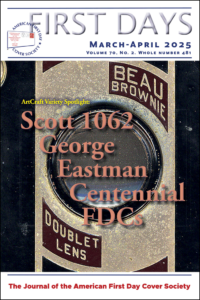 The new issue of First Days is online here.
The new issue of First Days is online here.
The feature article is on the ArtCraft cachets for the George Eastman FDCs of 1954 (Sc. 1062). Other articles include error postmarks on FDCs, cachets for Sc. 989 Statue of Freedom, Baffling Cachets and Part 2 of a checklist of cachets and cancellations for World Stamp Expo 2000.
Some additional news:
The AFDCS “central office” is closed for the entire month of April, although Your Faithful Officers (and the rest of us) try to pick up the slack.
You can pay electronically for items from the AFDCS (such as memberships or covers) without having or getting a PayPal account. You’ll find details here.
Scott US Update (April 2025)
 5958 (10¢) American Vistas – Beach and Sailboat
5958 (10¢) American Vistas – Beach and Sailboat
5959 (10¢) American Vistas – Mountains and House
a. Pair, #5958-5959
5960 Appalachian Trail pane of 15
a. (73¢) Hiker on Appalachian Trail
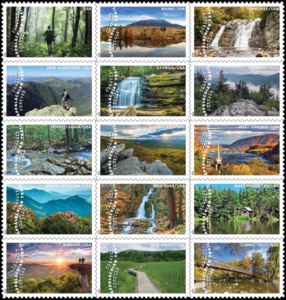 b. (73¢) Mount Katahdin, Maine
b. (73¢) Mount Katahdin, Maine
c. (73¢) Laurel Falls, Tennessee
d. (73¢) Hiker viewing Presidential Range, New Hampshire
e. (73¢) Long Creek Falls, Georgia
f. (73¢) Green Mountains, Vermont
g. (73¢) Creek along Appalachian Trail, Pennsylvania
h (73¢) Black Rock Cliffs, Maryland
i. (73¢) St. Peter’s Roman Catholic Church, Harpers Ferry, West Virginia
j. (73¢) Blue Ridge Mountains, North Carolina
k. (73¢) Fitzgerald Falls, New York
l. (73¢) Cabin on Mount Greylock, Massachusetts
m. (73¢) Hikers at McAfee Knob, Virginia
n. (73¢) Pochuck Boardwalk, New Jersey
o. (73¢) Ned Anderson Memorial Bridge, Connecticut
p. As #5960, imperforate
q. As #5960a, imperforate
r. As #5960b, imperforate
s. As #5960c, imperforate
t. As #5960d, imperforate
u. As #5960e, imperforate
v. As #5960f, imperforate
w. As #5960g, imperforate
x. As #5960h, imperforate
y. As #5960i, imperforate
z. As #5960j, imperforate
aa. As #5960k, imperforate
ab. As #5960l, imperforate
ac. As #5960m, imperforate
ad. As #5960n, imperforate
ae. As #5960o, imperforate
Nominations Open for Smithsonian Award
[press release] [click on any of the pictures for larger versions]
National Postal Museum Announces Nomination Process for Smithsonian Philatelic Achievement Award
Award Recognizes U.S. and International Philatelists
The Smithsonian’s National Postal Museum has announced the opening of the nominating process for the 2025 Smithsonian Philatelic Achievement Award. The Smithsonian award 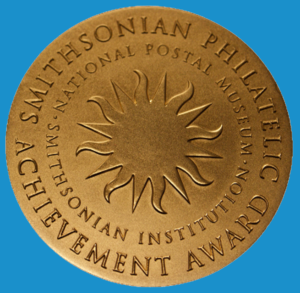 will recognize philatelists from the U.S. and international philatelic communities. The nomination process is open Feb. 18 through April 7. Award winners will be honored at a museum-hosted gala event in Washington, D.C., Nov. 8.
will recognize philatelists from the U.S. and international philatelic communities. The nomination process is open Feb. 18 through April 7. Award winners will be honored at a museum-hosted gala event in Washington, D.C., Nov. 8.
The Smithsonian Philatelic Achievement Award was established in 2002 to honor and celebrate living individuals for outstanding lifetime achievement in the field of philately. This achievement may include original research that significantly advances the understanding of philately, exceptional service to the philatelic community or sustained promotion of philately to the benefit of current and future collectors. The award celebrates excellence in philately on a global scale, recognizing individuals who have made outstanding contributions to the field worldwide. Nominations from outside the U.S. that reflect the rich diversity and international impact of philatelic scholarship, service and collecting are welcomed and encouraged.
The SPAA medallion is a 3-inch, gold-plated bronze disc depicting a sunburst with eight straight and eight wavy rays. Derived from the family coat of arms of James Smithson, founding benefactor of the Smithsonian Institution, the sunburst became the Institution’s official seal June 3, 1966, and is incorporated into the official flag flown by Smithsonian faciliti es and Smithsonian-sponsored expeditions throughout the world. As such, it is a universally recognized symbol of enlightenment and learning that links the Smithsonian’s history with its future. The medallion is suspended from a grosgrain neck ribbon in Smithsonian blue and yellow.
es and Smithsonian-sponsored expeditions throughout the world. As such, it is a universally recognized symbol of enlightenment and learning that links the Smithsonian’s history with its future. The medallion is suspended from a grosgrain neck ribbon in Smithsonian blue and yellow.
Eligibility criteria and information about the entry and judging processes can be found on the museum’s website. Award winners will be approved by the Smithsonian Board of Regents, consisting of the Chief Justice of the United States, the Vice President of the United States, three members of the United States Senate, three members of the United States House of Representatives and nine citizens.
About the Smithsonian’s National Postal Museum
The National Postal Museum is devoted to presenting the colorful and engaging history of 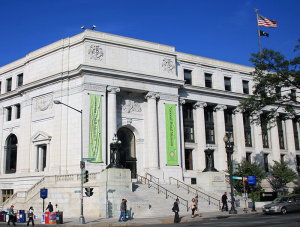 the nation’s mail service and showcasing one of the largest and most comprehensive collections of stamps and philatelic material in the world. Through the preservation and interpretation of our postal and philatelic collections, the Smithsonian’s National Postal Museum educates, challenges and inspires its audiences on the breadth of American experiences. It is located at 2 Massachusetts Ave. N.E., Washington, D.C., across from Union Station. The museum is open daily from 10 a.m. to 5:30 p.m. (closed Dec. 25). For more information about the Smithsonian, call (202) 633-1000 or visit the museum website at www.postalmuseum.si.edu.
the nation’s mail service and showcasing one of the largest and most comprehensive collections of stamps and philatelic material in the world. Through the preservation and interpretation of our postal and philatelic collections, the Smithsonian’s National Postal Museum educates, challenges and inspires its audiences on the breadth of American experiences. It is located at 2 Massachusetts Ave. N.E., Washington, D.C., across from Union Station. The museum is open daily from 10 a.m. to 5:30 p.m. (closed Dec. 25). For more information about the Smithsonian, call (202) 633-1000 or visit the museum website at www.postalmuseum.si.edu.
Blue Rodeo (Canada 2025)
[press release] [click on any of the pictures for larger versions]
New stamp celebrates Blue Rodeo
Since the band’s formation in 1984, its unique mix of country, folk and rock has helped shape Canadian music
TORONTO, April 3, 2025 /CNW/ – Today, Canada Post unveiled a new stamp to celebrate 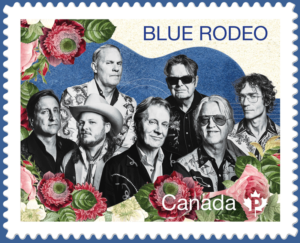 one of Canada’s most beloved bands, Blue Rodeo.
one of Canada’s most beloved bands, Blue Rodeo.
From the time it formed in 1984, the iconic group and its signature blend of country, folk and rock have helped define Canada’s musical identity – and 40 years on, Blue Rodeo continues to resonate deeply with loyal fans.
Led by the soaring harmonies and endearing melodies of principal singer-songwriters Jim Cuddy and Greg Keelor, Blue Rodeo performed a first live gig in February 1985. The band – known for rootsy eclecticism and superb musicianship – quickly became a fixture in Toronto’s epic Queen Street West music scene.
In 1987, the group released a debut album, Outskirts, with the first single “Try” becoming 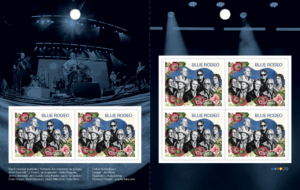 an instant hit. The song helped certify the record double platinum the following year and was the driving force behind Blue Rodeo’s five 1989 JUNO Award nominations – the band won Group of the Year, while “Try” won Single of the Year as well as Best Video.
an instant hit. The song helped certify the record double platinum the following year and was the driving force behind Blue Rodeo’s five 1989 JUNO Award nominations – the band won Group of the Year, while “Try” won Single of the Year as well as Best Video.
Building on this initial success, Blue Rodeo went on to release more than a dozen albums. Classic songs such as “Lost Together,” “5 Days in May” and “Hasn’t Hit Me Yet” propelled the band’s work to multi-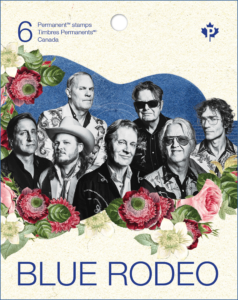 platinum status and turned the group, along with its members, into Canadian legends.
platinum status and turned the group, along with its members, into Canadian legends.
Among countless accolades, Blue Rodeo has won 12 JUNO Awards, including induction into the Canadian Music Hall of Fame, received a star on Canada’s Walk of Fame and earned a Governor General’s Performing Arts Award for Lifetime Artistic Achievement.
The band, which continues to tour and record, has sold more than four million albums and performed over 2,500 live shows, including more concerts at Toronto’s venerated Massey Hall than any other rock band.
About the stamp
The stamp features a collage of studio portraits of the seven current members of Blue 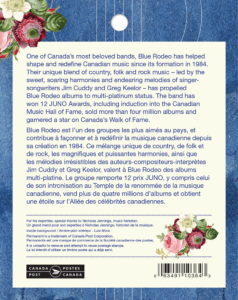 Rodeo. From left to right, Mike Boguski, Jimmy Bowskill, Jim Cuddy and Greg Keelor appear in the front row, with Colin Cripps, Bazil Donovan and Glenn Milchem in the back row.
Rodeo. From left to right, Mike Boguski, Jimmy Bowskill, Jim Cuddy and Greg Keelor appear in the front row, with Colin Cripps, Bazil Donovan and Glenn Milchem in the back row.
The stamp was designed by Jim Ryce. It features photography by Luis Mora and illustration work by Katy Lemay, along with flower illustrations from thegraphicsfairy.com. It was printed by Colour Innovations. The issue includes a booklet of six Permanent™ stamps and an Official First Day Cover. The cancel site is Toronto, Ontario, where the band is based; the cancel mark is a guitar pick with a flower at its centre, reminiscent of the floral details that appear on the band’s western-style shirts.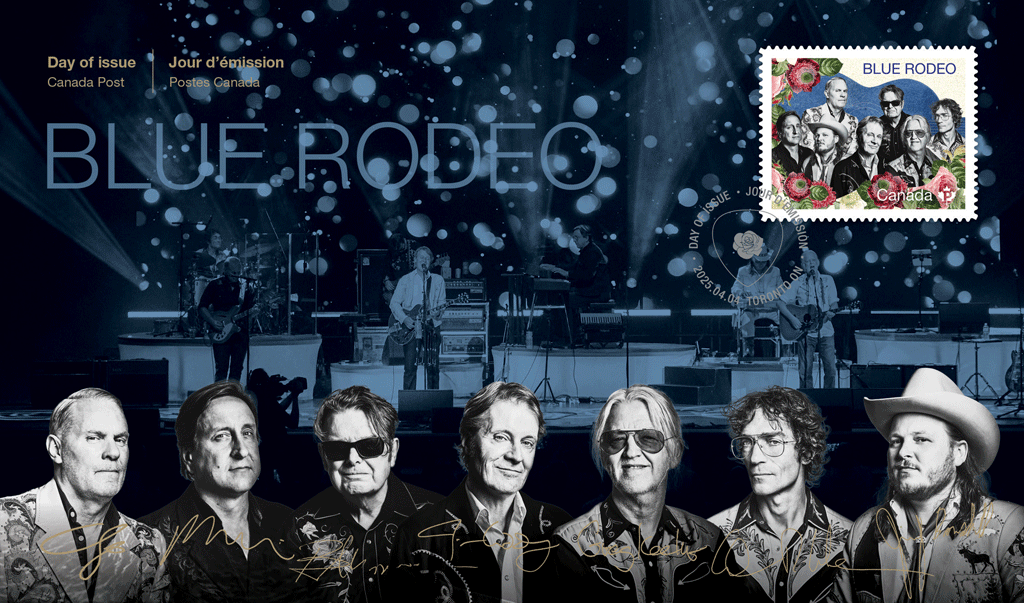
Stamps and collectibles are available at canadapost.ca and postal outlets across Canada.
[en Francais pour les médias d’information]
Un nouveau timbre rend hommage à Blue Rodeo
Depuis la formation du groupe en 1984, son mélange unique de country, de folk et de rock a façonné la musique canadienne.
 TORONTO, le 3 avril 2025 /CNW/ – Aujourd’hui, Postes Canada a dévoilé un timbre saluant l’un des groupes canadiens les plus aimés, Blue Rodeo.
TORONTO, le 3 avril 2025 /CNW/ – Aujourd’hui, Postes Canada a dévoilé un timbre saluant l’un des groupes canadiens les plus aimés, Blue Rodeo.
Depuis ses débuts en 1984, le groupe emblématique contribue avec son style de musique – un mélange unique de country, de folk et de rock – à définir l’identité musicale du Canada. Une quarantaine d’années plus tard, Blue Rodeo ne cesse de séduire son fidèle public.
Guidé par les puissantes harmonies et les mélodies irrésistibles des auteurs-compositeurs-interprètes principaux Jim Cuddy et Greg Keelor, Blue Rodeo se produit pour la première fois en février 1985. Reconnu pour son style éclectique aux accents roots et sa superbe musicalité, le groupe se taille rapidement une place sur la légendaire scène  musicale de la rue Queen Ouest à Toronto.
musicale de la rue Queen Ouest à Toronto.
En 1987, le groupe lance son premier album, Outskirts, dont le premier titre, « Try », connaît un succès instantané. La chanson contribue à la certification double platine de l’album l’année suivante, et le groupe obtient cinq nominations aux prix JUNO en 1989, où il remporte le titre du groupe de l’année, tandis que « Try » est couronnée single de l’année et vidéoclip de l’année.
Fort de son succès initial, Blue Rodeo sort plus d’une douzaine d’albums. Des classiques  tels que « Lost Together », « 5 Days in May » et « Hasn’t Hit Me Yet » lui valent des albums maintes fois platine et hissent le groupe et ses membres au rang des légendes canadiennes.
tels que « Lost Together », « 5 Days in May » et « Hasn’t Hit Me Yet » lui valent des albums maintes fois platine et hissent le groupe et ses membres au rang des légendes canadiennes.
Blue Rodeo reçoit de nombreuses distinctions : 12 prix JUNO, dont celui de son intronisation au Temple de la renommée de la musique canadienne, une étoile sur l’Allée des célébrités canadiennes et un Prix du Gouverneur général pour les arts du spectacle de la réalisation artistique.
Le groupe, qui se produit et enregistre toujours, a vendu plus de quatre millions d’albums et présenté plus de 2 500 spectacles sur scène, y compris au prestigieux Massey Hall de Toronto, où il se produit plus souvent que toute autre formation rock.
À propos du timbre
Le timbre présente un collage de portraits des sept membres actuels de Blue Rodeo. De  gauche à droite dans la rangée avant, Mike Boguski, Jimmy Bowskill, Jim Cuddy et Greg Keelor, puis Colin Cripps, Bazil Donovan et Glenn Milchem dans la rangée arrière.
gauche à droite dans la rangée avant, Mike Boguski, Jimmy Bowskill, Jim Cuddy et Greg Keelor, puis Colin Cripps, Bazil Donovan et Glenn Milchem dans la rangée arrière.
Le timbre a été conçu par Jim Ryce. Il présente le travail du photographe Luis Mora et de l’illustratrice Katy Lemay, ainsi que des illustrations de fleurs de thegraphicsfairy.com. Il a été imprimé par Colour Innovations. L’émission comprend un carnet de six timbres PermanentsMC et un pli Premier Jour officiel. Le timbre est oblitéré à Toronto, où réside le groupe; le cachet d’oblitération est un médiator de guitare orné d’une fleur rappelant les détails floraux des chemises westerns des membres du groupe.
Les timbres et les articles de collection sont en vente sur postescanada.ca et dans les comptoirs postaux partout au pays.
The earlier preview announcement:
[press release] [click on any of the pictures for larger versions]
Canada Post to unveil stamp honouring award-winning Canadian band Blue Rodeo
TORONTO, March 31, 2025 /CNW/ Canada Post invites you to the unveiling of a new 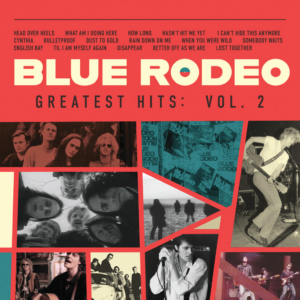 commemorative stamp honouring award-winning Canadian band Blue Rodeo on Thursday, April 3 at the Opera House.
commemorative stamp honouring award-winning Canadian band Blue Rodeo on Thursday, April 3 at the Opera House.
Official Website • Wikipedia • AllMusic
Since its formation in 1984, Blue Rodeo has won 12 JUNO Awards, including induction into the Canadian Music Hall of Fame, received a star on Canada’s Walk of Fame and earned a Governor General’s Performing Arts Award for Lifetime Artistic Achievement.
The stamp unveiling will be a private event, by invitation only. Interviews will be available on site.
WHAT: Blue Rodeo stamp unveiling
WHEN: Thursday, April 3; doors open at 5:30 p.m. and event starts at 6 p.m.
WHERE: The Opera House, 735 Queen Street East, Toronto
RSVP: Media interested in attending the private stamp unveiling are asked to confirm their attendance by email to media@canadapost.ca.
[en Francais pour les médias d’information]
Postes Canada dévoilera un timbre en hommage au groupe primé Blue Rodeo
TORONTO, le 31 mars 2025 /CNW/ Postes Canada vous invite au dévoilement d’un timbre commémoratif rendant hommage au groupe canadien primé Blue Rodeo le jeudi 3 avril à l’Opera House.
Depuis sa formation en 1984, Blue Rodeo a reçu de nombreuses distinctions: 12 prix JUNO, intronisation au Temple de la renommée de la musique canadienne, une étoile sur l’Allée des célébrités canadiennes et un Prix du Gouverneur général pour les arts du spectacle de la réalisation artistique.
Le dévoilement du timbre sera un événement privé, sur invitation seulement. Des entrevues pourront avoir lieu sur place.
QUOI: Dévoilement du timbre saluant Blue Rodeo
QUAND: Le jeudi 3 avril; les portes ouvriront à 17 h 30 et l’événement commencera à 18 h.
OÙ: The Opera House
-735, rue Queen Est, Toronto
RSVP: Les médias qui souhaitent assister au dévoilement privé doivent confirmer leur présence par courriel à media@postescanada.ca.
Lazaroff Now Top Boston 2026 Commissioner
[press release] [click on any of the pictures for larger versions]
Boston 2026 Commissioner Reorganization
Chris Lazaroff has been appointed as the Commissioner General of Boston 2026,  replacing Yamil Kouri who will continue as the exhibition’s President.
replacing Yamil Kouri who will continue as the exhibition’s President.
“As work progresses it became clear that it would be best that I concentrate my time solely on my leadership role and turn the important responsibilities of the exhibits to someone else,” said Kouri. “Chris is eminently qualified to handle the position, assisted by Deputy Commissioner General Dzintars Grinfelds.”
Lazaroff was earlier selected to be the show’s U.S. East Commissioner in addition to his role as United States Postal Service Liaison.
Tom Fortunato of Rochester, New York, is assuming the East Commissioner post while continuing as Public Relations Chair. He had been the exhibits chair for the national ROPEX stamp show for two decades and has been a jointly certified APS/ATA judge since 2000.
Kouri continued, “These reassignments strengthen our Boston 2026 team and commitment to exhibiting participants in particular. We welcome Chris and Tom’s willingness to add to their present show duties.”
Boston 2026 World Expo takes place May 23-30, 2026, at the Boston Convention & Exhibition Center. Full show details may be found at Boston2026.org and on Twitter and Facebook. Sign up to be added to the Boston 2026 email list and receive updates when available.
U.S. Postmaster General Quits Suddenly
U.S. Postmaster General Louis DeJoy resigned suddenly Monday, March 24, just weeks after saying he wanted to leave, but would stay until a successor was named. A major 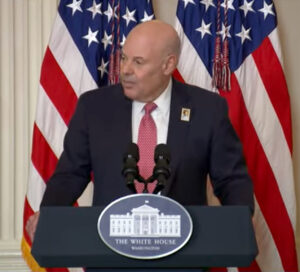 contributor to President Trump’s first bid for the White House, he was named PMG in 2020 by a USPS Board of Governors largely appointed by President Trump.
contributor to President Trump’s first bid for the White House, he was named PMG in 2020 by a USPS Board of Governors largely appointed by President Trump.
DeJoy and the USPS have faced increasing criticism from the Trump administration, with the president and Elon Musk calling for its privatization. Democrats say that would violate federal law. President Trump was very unhappy with DeJoy and the USPS for aid voting by mail in the 2020 presidential election.
President Trump has also floated the idea of ending the Postal Service’s independent- agency status and putting it in the Commerce Department.
agency status and putting it in the Commerce Department.
DeJoy’s “Delivering for America” modernization plan has rankled many USPS employees and major mailers. However, his refusal to give DOGE officials broad access, as reported by The Washington Post, certainly did not sit well with the administration.
The newspaper reports that in recent days, administration officials have met with Jim Cochrane, the chief executive of the Package Shippers Association, a trade group that represents companies including Amazon, DHL and FedEx, about replacing DeJoy. Cochrane is reportedly a leading candidate to replace DeJoy.
 The acting Postmaster General now is Doug Tulino, who rose to that position in 2021. He retained the position of Chief Human Resources Officer, to which he was named in November 2020.
The acting Postmaster General now is Doug Tulino, who rose to that position in 2021. He retained the position of Chief Human Resources Officer, to which he was named in November 2020.
Tulino began his career with the USPS as a management associate in Chicago in 1980. His entire career with the Postal Service has been in management.
AFDCS Adds Member No. 30,000
[press release] [click on any of the pictures for larger versions]
AFDCS Signs Up Member Number 30,000 At Show
Edward Pieper of the St. Louis area is the 30,000th person to join the American First Day Cover Society. He was signed up at St. Louis Stamp Expo on Saturday, March 22, by 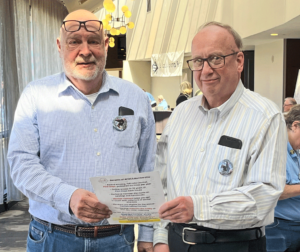 Foster Miller at the AFDCS table at the show. (Photo: Pieper, left, Miller, right)
Foster Miller at the AFDCS table at the show. (Photo: Pieper, left, Miller, right)
Pieper now has a credit with the AFDCS of 30,000 pennies — $300. He can spend it on
the AFDCS.org website, buying FDCs, catalogues and handbooks; renewing or upgrading his membership; paying for successful AFDCS auction bids; and more. Miller, as the person who recruited member #30,000, also was awarded a $300 credit, which he will be donating to the AFDCS Endowment Fund.
The AFDCS today does not have 30,000 members: It is closer to 1,000. Some numbers may have been skipped; some people may have received more than one number over the years; and, of course, some former members have passed away or no longer collect.
The AFDCS, founded in 1955, is the largest not-for-profit first day cover society in the world, with members in more than a dozen countries. It publishes an award-winning journal, First Days, six times a year, as well as handbooks, catalogues and You-Tube videos; holds fundraising auctions; is a co-sponsor of the annual Great American Stamp Show, conducts an annual cachetmaking contest; and encourages philatelic exhibiting and writing about FDCs.
For more information about the AFDCS, visit www.afdcs.org, e-mail afdcs@afdcs.org or write the AFDCS at Post Office Box 57, Somerset, WI 54025-0057.



